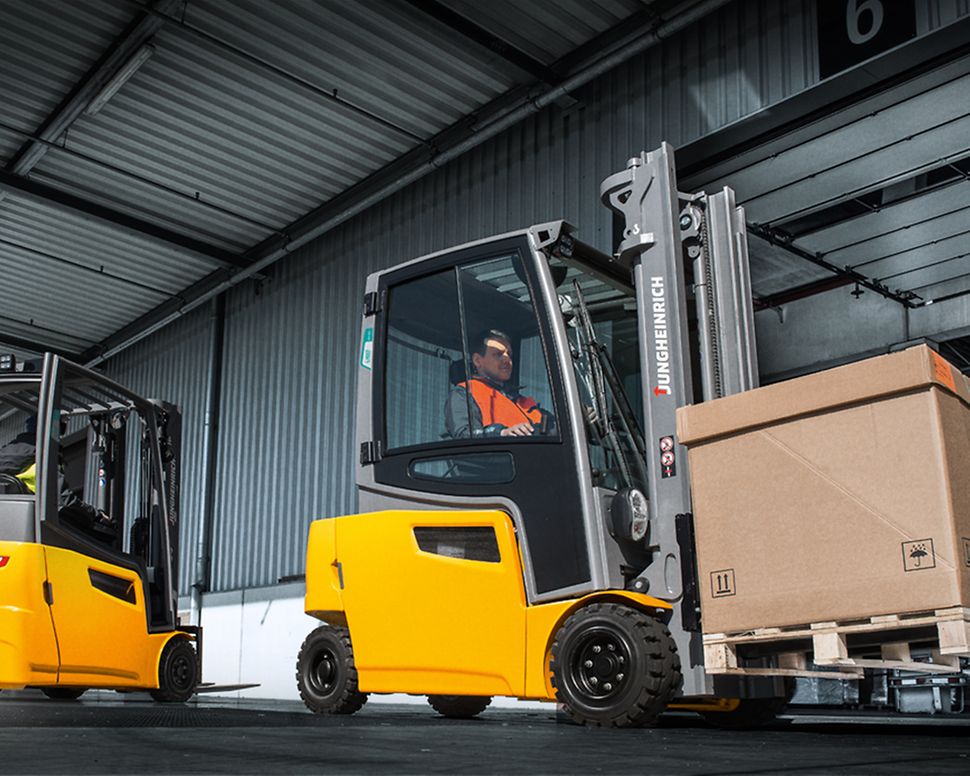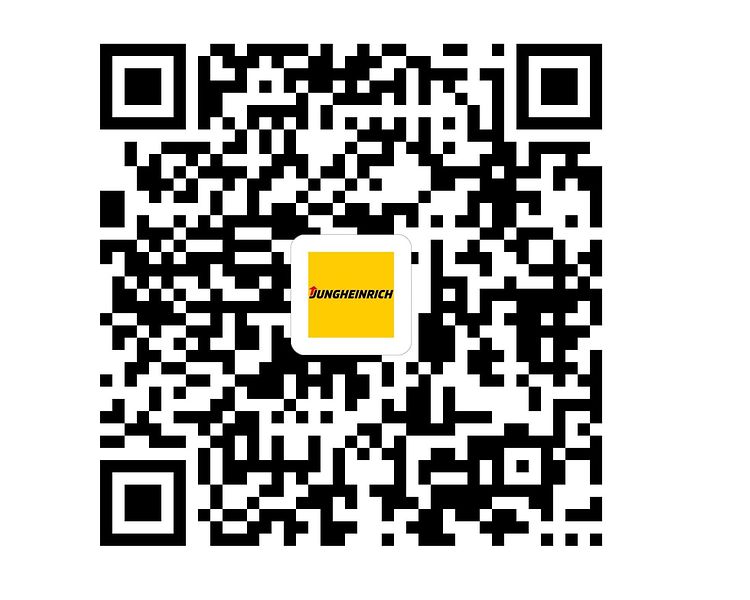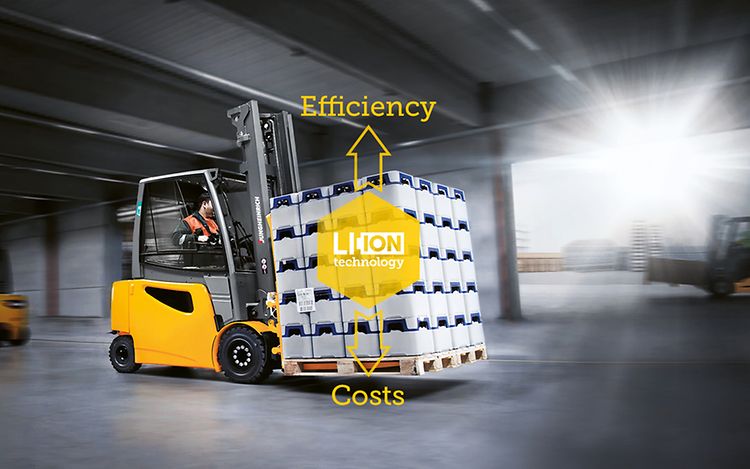
平衡重叉车
叉车 - 高效的全能型叉车
我们的叉车几乎可以在任何仓库中使用,它们是真正的全能型车型。无论是紧凑型电动车型还是超强动力内燃机 - 我们的低消耗平衡重式叉车都能为您提供正确的选择。
适合各种需求的正确叉车
您在寻求强大的性能同时兼具更高的成本效益吗?我们的叉车提供两种。它们非常灵活,可以在大厅和院子里可靠地运输货物至目的地。由于它们的高负载能力,即使重载也不会对平衡重式叉车造成问题:毫不费力地提升到五吨。
平衡重式叉车:电动还是内燃机?
我们的产品系列包括电动叉车和带内燃机的叉车。哪种类型更合适取决于您仓库的个性化需求。
在窄通道仓库中,您将通过我们的电动平衡重式叉车实现更高性能。凭借创新的三相技术,它们在操控,操控和维护成本方面也脱颖而出。同时,再生制动为叉车提供了额外的能量,因此您只需一次充电即可完成更多工作。
另一方面,通过我们的柴油和天然气叉车,您可以依靠坚固可靠的动力装置。它们的额定荷载在1.6到5吨之间,从而确保更高效率。然而,我们的平平衡重式叉车低噪音且符合人体工程学。如果您需要改变仓库中的方向,应该选择一辆带静液压传动的卡车。另一方面,从在长距离运输中,您可以通过液力传动更好地驾驶。

了解更多讯息,欢迎致电
FAQs about our forklift trucks:
1. What is a forklift?
A forklift truck is a three-wheel or four-wheel industrial truck primarily used for the internal handling and transport of goods and merchandise. In contrast to simple, forklifts have their own drive and a mast, which not only allows loads to be picked up but also to be stacked.
The forklift truck is named after the fork carrier, which is usually used to pick up pallets and pallet cages. The fork carrier usually consists of two, more rarely also several steel forks, which are called fork tines. Although other types of forklift trucks also have forks, they do not belong to the forklift truck category, but are named after other, more distinct aspects, for example, the reach truck.
2. What are forklift trucks used for?
The typical use of forklift trucks is the handling of goods, for example loading and unloading trucks and larger vehicles. Forklifts are also used for classic internal transport, for example to supply a production facility or to store goods. They may also be used for special purposes; for example, setting up and dismantling trade fairs and events.
3. Where are forklift trucks used?
Depending on the type and application, forklift trucks are used in different areas. In general, however, forklifts are an important foundation for goods handling and transport across almost all industries. This applies to the automotive sector and the manufacturing industry as well as to the food and beverage industry and logistics companies. Forklift trucks are used both indoors (e.g. in halls and warehouses) and outdoors (e.g. on company premises, at the port or airport, or at event locations).
Depending on the type of drive, the possible application differs: Electric forklifts are suitable not only for indoor but also for outdoor use whereas gas and diesel are more difficult. Gas forklifts must meet special safety and emission regulations in order to be allowed to be used indoors. Diesel forklifts are basically only used outdoors.
4. How does a forklift truck work?
How a forklift truck works depends on the type and construction of the truck. In general, however, the function is based on the so-called lifting unit, consisting of the lift mast and fork carrier. The forks of the forklift truck make it possible to place the lifting mechanism under pallets and other loads in order to lift them. These are then usually lifted for transport or stacking by means of a lifting mast, hydraulic cylinder and lifting chains. In addition to fork carriers with forks, other load handling devices such as mandrels, clamps or tippers can also be used on front loaders and other types of forklift trucks.
5. What types of forklift trucks are available?
Forklift trucks, also known counterbalance trucks, in the strictest sense of the word are so-called front loaders, which operate according to the counterbalance principle. The forks are located at the front of the truck. The load weight picked up by the fork is balanced by a correspondingly high counterweight at the rear.
There are also other, special types of forklift trucks. These include the so-called reach truck that pushes the mast forwards and then back again to pick up the load, so that the load's centre of gravity is no longer at the front but between the truck's axles. Other forklift types are high-bay stackers, which are used to load and unload goods on a rack system in the high-bay warehouse, and order picking trucks, whose primary purpose is to collect goods according to specified orders.
The so-called pallet truck is another variant but is usually not counted among the classic forklifts. Pedestrian stackers are also called high-lift trucks and are generally considered part of the lifting truck category.
6. What types of drive are there?
When it comes to drives, a fundamental distinction is made between forklift trucks with electric motors and with internal combustion (IC) engines.
Electromotive forklifts draw their energy from the forklift battery. Lead-acid batteries and lithium-ion batteries are used here.
With combustion engine forklifts, a distinction is made between diesel forklifts and gas or LPG forklifts. The latter are operated either with natural gas or liquid gas (LPG, Liquefied Petroleum Gas), depending on the type. Although gasoline forklifts also belong to the category of IC engine forklifts, they are rarely used in the European Union.
Furthermore, a distinction is made between hydrostatic and hydrodynamic drives for IC engine trucks. Hydrodynamic drives are usually found in the simpler IC engine-powered forklifts, also known as "V-stackers", and are well suited for transport tasks. Hydrostatic drives, on the other hand, are generally associated with faster acceleration, more precise steering and easy reversing. This makes forklifts with hydrostatic drives ideal for goods handling such as loading and unloading trucks.
7. What are the advantages/disadvantages of electric motor-driven forklift trucks?
The advantages of electric forklift trucks include their high efficiency and versatility. Since such front forklifts are emission-free, their use is possible both indoors and outdoors. The low-noise and emission-free operation protects employees and protects the environment.
Compared with IC engine-powered vehicles, forklifts with lithium-ion batteries are particularly attractive due to their very low operating and maintenance costs.
A possible disadvantage of electric forklifts with lead-acid batteries is that the batteries may need to be exchanged more frequently when they are used for a very long time and intensively. Due to their much higher energy efficiency, however, counterbalance trucks and other types of trucks with lithium-ion batteries do not have this problem.
Furthermore, most electric-powered trucks generally require good floor conditions, especially in terms of ground clearance and protection against dust and dirt. However, Jungheinrich also develops and produces electrically powered trucks that are specially optimised for outdoor use.
8. What types of battery are available for electric forklift trucks?
For forklift trucks with electric motors, two primary types of truck batteries are used: lead-acid batteries and lithium-ion batteries. The latter offer some convincing advantages and are thus establishing themselves as the new standard. Lithium-ion batteries, for example, are better environmentally, more energy efficient and they deliver consistently good performance even when the battery is already partially discharged. They are also maintenance-free and have a long service life.
Our lithium-ion stackers form an optimally coordinated system of forklift, lithium-ion battery and charging technology.
9. What are the advantages/disadvantages of IC engine forklifts?
In general, diesel and gas forklift trucks are more powerful and can therefore handle heavy loads and difficult tasks in, for example, dusty and uneven working environments. However, as a pioneer in lithium-ion technology, the electric forklifts from Jungheinrich are now so powerful that they can stand up in comparison with IC engine trucks in many cases while scoring points for greater efficiency.
Advantages of IC engine-powered trucks include being able to deal with uneven floors and that they are ready for use at all times thanks to zero charging time. The disadvantages of IC engine-powered forklift trucks are higher operating costs, more noise and greater emission values, which is why they are usually only used outdoors.
10. What gas/propellant is required for forklift trucks?
Gas forklift trucks are powered by either natural gas or LPG. LPG consists of a propane/butane mixture.
11. What is the lifting capacity of a forklift truck?
The lifting capacity of forklift trucks differs depending on the construction and drive system. Counterbalanced trucks from Jungheinrich can lift loads of up to 5 t in weight, whereby the load capacity decreases with increasing lifting height. You can find details on the load capacity of the individual truck models in our technical product sheets.
12. What is the lifting height of a forklift truck?
The lifting height of forklift trucks depends on various factors. Counterbalanced trucks from Jungheinrich can reach heights of up to 7.5 m. For details on the actual lifting height of the various forklift models, please refer to our technical product sheets.
13. How fast can a forklift truck travel?
The maximum travel speed of forklift trucks varies. Depending on the model, Jungheinrich counterbalance trucks can reach speeds of up to 22 km/h without load. Details of the actual travel speed with and without load can be found in our technical product sheets for the individual truck models.
14. Are there explosion-proof forklifts?
Yes. As part of our special construction, you can also obtain so-called explosion-proof forklifts from our Ex-Protection Competence Centre, which fully meet your safety requirements in potentially explosive areas. Jungheinrich thus offers you safe solutions for using forklift trucks in environments with flammable gases and vapours as well as explosive powders and dusts, for example in the chemical and pharmaceutical industries.
Our explosion-protection trucks are always from the current series, hardly differ from their conventional counterparts in terms of performance and design and offer the highest ergonomic standards. Service technicians specially trained in explosion protection ensure that your explosion-protected truck remains fully operational for many years and passes all legally required tests with top marks.
15. Are there forklifts for cold storage?
Yes. Our forklifts offer maximum functional reliability even at -20 °C. They can be equipped with cold storage cabins and different types of windows as a configuration option.
16. Are there forklifts with closed cabs?
Basically, all Jungheinrich trucks, whether forklift trucks, reach trucks, order pickers or high-bay stackers, have a driver's cab. For safe operation in different environments and under changing weather conditions, Jungheinrich offers forklift variants with an enclosed driver's cab.
17. Why do we say forklift?
The term "stacker" is often used synonymously with "forklift truck". However, this designation emphasises the industrial truck's ability not only to lift palletised goods but also to stack them. However, as this also applies to other industrial trucks, the general category term "forklift" includes not only the forklift in the narrower sense (i.e. the counterbalanced forklift) but also other variants such as reach trucks, high-bay stackers, order pickers and pedestrian stackers.
18. Why do we say front loader?
The term "front loader" includes all trucks where the fork carriage or forks are located at the front. In addition, the driver's seat or cab is usually facing the direction of travel. A classic forklift truck is considered a front loader.
19. Why is a counterbalance truck called a counterbalance truck?
The typical forklift truck, as it is most widely used, operates according to the so-called counterbalance principle. This means that the load weight on the forks at the front is balanced by a counterweight at the rear. When we talk about a forklift truck, we usually mean a counterbalance truck.
20. What is a pedestrian-controlled forklift truck?
The term "pedestrian-controlled forklift truck" is used relatively rarely and refers to forklift trucks that are controlled by pedestrians rather than a driver. These industrial trucks are guided by a drawbar and are also called "high-lift trucks". In practice, they do not count as forklifts but as pallet trucks.
21. Which forklift truck can I use in a warehouse?
In principle, all electric motor-driven forklift trucks can be used in the warehouse. If strict safety and emission regulations are observed, gas forklifts can also be used in the warehouse in some cases. Diesel forklifts are basically always ruled out for indoor use.
22. Which forklift truck is suitable for outdoor use?
For outdoor use, we recommend all IC engine forklifts such as diesel and LPG forklifts. In general, electric motor-driven forklifts are less suitable for outdoor use because they place higher demands on ground clearance and protection against dust and dirt. However, Jungheinrich also develops electrically powered forklift trucks that can cope with outdoor use without any problems.
23. Which forklift truck is suitable for narrow aisle widths in warehouses?
Depending on the aisle width, different electric forklift trucks can be used in the warehouse. This is especially true for our very compact three-wheel electric forklifts in the 1 series, which have extremely compact dimensions and a width of only 990 mm – usually ideal for safe use even in narrow aisles. For the typical narrow aisle warehouse, however, reach trucks or high-bay stackers are still recommended rather than counterbalanced trucks.
24. Where can I find the user manual for my forklift truck?
You can find the corresponding user manuals for our forklift trucks as a PDF download on our operating manual search page.
Buy or lease a forklift – Jungheinrich forklift sales.
If your vehicle fleet is still missing a high-performing forklift that can reliably carry out a variety of warehouse tasks, then there’s no reason to worry. You can contact our specialist consultants by filling out a product enquiry form. They will be happy to support you in selecting the right forklifts. You can also buy additional transport and storage boxes as well as other forklift truck accessories for your truck fleet in the Jungheinrich PROFISHOP.
If you don’t want to buy a fork lift outright and would like to find out more about the financing options available for these practical warehouse tools, our Jungheinrich financial consultants are here for you. Together, we will determine whether purchasing in instalments, leasing or a forklift truck rental agreement is the best option for you.
We’re also happy to talk about short-term solutions: If you have to cope with peaks in demand or increase handling performance in seasonal business, we offer rental trucks for temporary use via the forklift hire consulting service.
新闻稿
立即登录